
Samuel Jones Tilden was an American politician who served as the 25th governor of New York and was the Democratic nominee in the disputed 1876 United States presidential election.

John La Farge was an American artist whose career spanned illustration, murals, interior design, painting, and popular books on his Asian travels and other art-related topics. La Farge made stained glass windows, mainly for churches on the American east coast, beginning with a large commission for Henry Hobson Richardson's Trinity Church in Boston in 1878, and continuing for thirty years. La Farge designed stained glass as an artist, as a specialist in color, and as a technical innovator, holding a patent granted in 1880 for superimposing panes of glass. That patent would be key in his dispute with contemporary and rival Louis Comfort Tiffany.

The National Academy of Design is an honorary association of American artists, founded in New York City in 1825 by Samuel Morse, Asher Durand, Thomas Cole, Martin E. Thompson, Charles Cushing Wright, Ithiel Town, and others "to promote the fine arts in America through instruction and exhibition." Membership is limited to 450 American artists and architects, who are elected by their peers on the basis of recognized excellence.

Gramercy Park is the name of both a small, fenced-in private park, and the surrounding neighborhood that is also referred to as Gramercy, in Manhattan in New York City.
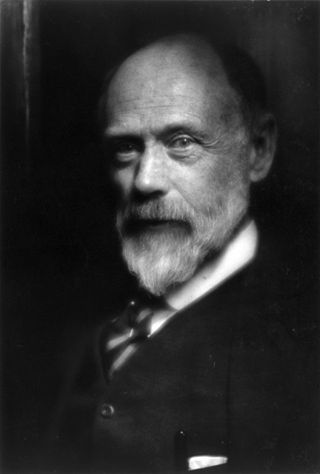
Samuel Herbert Adams was an American sculptor.

The 69th Regiment Armory is a historic armory for the U.S. Army National Guard at 68 Lexington Avenue, between East 25th and 26th Streets, in the Rose Hill neighborhood of Manhattan in New York City, United States. Completed in 1906, the armory was designed by the firm of Hunt & Hunt in the Beaux-Arts style. The building is a New York City designated landmark and is listed on the National Register of Historic Places as a National Historic Landmark.

The Players is a private social club founded in New York City by the noted 19th-century Shakespearean actor Edwin Booth.
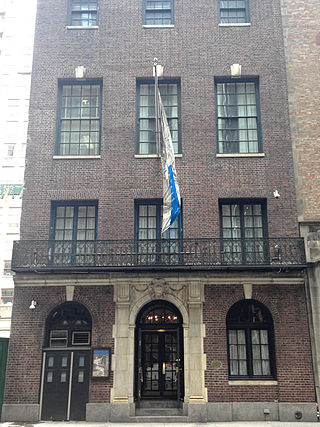
The Grolier Club is a private club and society of bibliophiles in New York City. Founded in January 1884, it is the oldest existing bibliophilic club in North America. The club is named after Jean Grolier de Servières, Viscount d'Aguisy, Treasurer General of France, whose library was famous; his motto, "Io. Grolierii et amicorum" [of or belonging to Jean Grolier and his friends], suggested his generosity in sharing books.
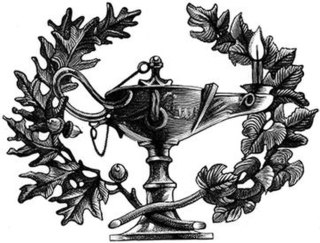
The Century Association is a private social, arts, and dining club in New York City, founded in 1847. Its clubhouse is located at 7 West 43rd Street near Fifth Avenue in Midtown Manhattan. It is primarily a club for men and women with distinction in literature or the arts. The Century Association was founded by members of New York's Sketch Club; preceding clubs also included the National Academy of Design, the Bread and Cheese Club, and the Column. Traditionally a men's club, women first became active in club life in the early 1900s; the organization began admitting women as members in 1988.

The Samuel J. Tilden House is a historic townhouse pair at 14-15 Gramercy Park South in Manhattan, New York City. Built in 1845, it was the home of Samuel J. Tilden (1814–1886), former governor of New York, a fierce opponent of the Tweed Ring and Tammany Hall, and the losing presidential candidate in the disputed 1876 election. Tilden lived in the brownstone from 1860 until his death in 1886. From 1881 to 1884, Calvert Vaux combined it with the row house next door, also built in 1845, to make the building that now stands, which has been described as "the height of Victorian Gothic in residential architecture" with Italian Renaissance style elements. Since 1906 it has been the headquarters of the National Arts Club, a private arts club.

The Whitney Museum of American Art's original building is a collection of three 1838 rowhouses at 8–12 West 8th Street, between Fifth Avenue and MacDougal Street, in the Greenwich Village neighborhood of Manhattan in New York City. In 1907, Gertrude Vanderbilt Whitney established the Whitney Studio Gallery at 8 West 8th Street adjacent to her own MacDougal Alley studio. This, and the later Whitney Studio Club at 147 West 4th Street, were intended to provide young artists with places to meet and exhibit their works.
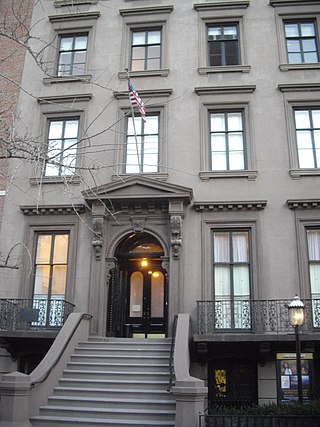
The Salmagundi Club, sometimes referred to as the Salmagundi Art Club, is a fine arts center founded in 1871 in the Greenwich Village section of Manhattan, New York City. Since 1917, it has been located at 47 Fifth Avenue. As of 2021, its membership roster totals roughly 1,250 members.
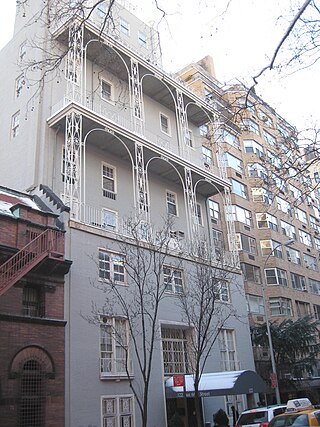
The Cosmopolitan Club is a private social club on the Upper East Side of Manhattan in New York City, New York, United States. Located at 122 East 66th Street, east of Park Avenue, it was founded as a women's club. Members have included Willa Cather, Ellen Glasgow, Eleanor Roosevelt, Jean Stafford, Helen Hayes, Pearl Buck, Marian Anderson, Margaret Mead, and Abby Aldrich Rockefeller.
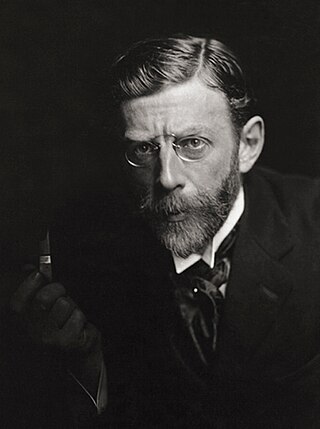
Leon Dabo was an American tonalist landscape artist best known for his paintings of New York State, particularly the Hudson Valley. His paintings were known for their feeling of spaciousness, with large areas of the canvas that had little but land, sea, or clouds. During his peak, he was considered a master of his art, earning praise from John Spargo, Bliss Carman, Benjamin De Casseres, Edwin Markham, and Anatole Le Braz. His brother, Scott Dabo, was also a noted painter.

Church Missions House is a historic building at Park Avenue South and East 22nd Street in the Gramercy Park neighborhood of Manhattan in New York City. Part of an area once known as "Charity Row", the building was designed by Robert W. Gibson and Edward J. Neville Stent, with a steel structure and medieval-inspired facade. The design was inspired by the town halls of Haarlem and medieval Amsterdam. Church Missions House is so named because it was the headquarters of the Episcopal Church's Domestic and Foreign Missionary Society for much of the 20th century.

Fotografiska is a centre for contemporary photography in the Södermalm district of Stockholm, Sweden that was founded by brothers Jan and Per Broman and opened on 21 May 2010. In March 2021, it merged with NeueHouse and is operated by Yoram Roth and Josh Wyatt under the parent company CultureWorks.
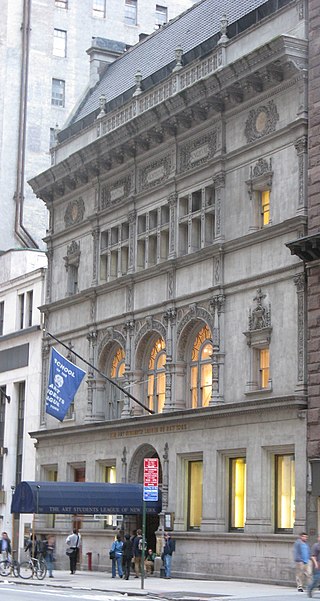
The Art Students League of New York Building is a building on 57th Street in Midtown Manhattan in New York City. The structure, designed by Henry Janeway Hardenbergh in the French Renaissance style, was completed in December 1892 and serves as the headquarters of the Art Students League of New York. The building was developed by the American Fine Arts Society (AFAS), formed in 1889 by five organizations including the Art Students League, the Society of American Artists, and the Architectural League of New York.
The National Association of Women Artists, Inc. (NAWA) is a United States organization, founded in 1889 to gain recognition for professional women fine artists in an era when that field was strongly male-oriented. It sponsors exhibitions, awards and prizes, and organizes lectures and special events.

Sergio Rossetti Morosini is a Contemporary Brazilian-American Scholar, artist and author of Venetian extraction who served as Brazil's Cultural attaché in New Orleans and is also dedicated to preserving the Atlantic Forest and restoring the art in stone of New York City Landmarks.

The Lenox Library was a library incorporated and endowed in 1870. It was both an architectural and intellectual landmark in Gilded Age–era New York City. It was founded by bibliophile and philanthropist James Lenox, and located on Fifth Avenue between 70th and 71st Streets on the Upper East Side of Manhattan. Renowned architect Richard Morris Hunt designed the building, which was considered one of the city's most notable buildings, until its destruction in 1912.


























